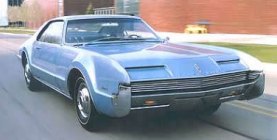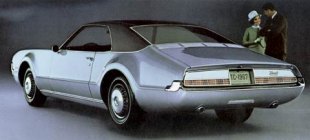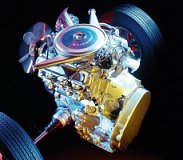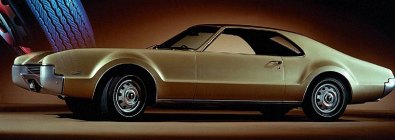  Another landmark design by General Motors in the 1960s was Oldsmobile Toronado. This luxury grand tourer took some inspiration from the 1961 Lincoln Continental (most notably the blade fenders) but finished in a more futuristic form. The sleek nose contains a thin horizontal grille and hidden headlamps in a neat and tasteful way. The combination of a long hood and a short fastback tail marks it out from contemporary American cars. Oldsmobile would never produce a car so beautiful again. Apart from design, Toronado was also famous for being front-wheel driven. Its 385 horsepower 7-liter V8 was mounted longitudinally in the engine compartment. The 3-speed automatic transmission had its torque converter located right behind the engine and the gearbox at the left side of the engine. Power transferred from the torque converter to the gearbox through a specially designed chain. This resulted in a compact layout which allowed the engine to be placed behind the front axle to reduce nose heaviness. The innovative front-drive system took Oldsmobile 7 years to develop and evaluate.   The chassis was a semi-monocoque - the engine and transmission were mounted on frame rails while a monocoque was used from the firewall rearward. The double-wishbone front suspensions employed torsion bars instead of coil springs to make space for the front-drive system. The rear was a conventional rigid axle on leaf springs. The Toronado was not exactly a big car by American standard, but it was still big and heavy for the rest of the world. Its two large doors gave easy access to the roomy rear seats. The interior was well designed and comfortable, if not as luxuriously equipped as Cadillac. Amazingly, the Toronado was so well engineered that it showed virtually no torque steer, which was an achievement considering the big V8 produced 475 lbft of torque. With more weight on the driving wheels, it offered superior traction compare with conventional FR cars, which was especially useful on wet roads. Most magazines commented favourably on its handling, describing it as among the best handling big cars of the time. Weaknesses were few, namely, weak brakes, no steering feel and the inability of power slide. The Toronado performed well against the clock - Car Life magazine measured 0-60 mph in 7.5 seconds while Car and Driver recorded an impressive 135 mph top speed, thanks to its wind-cheating shape. Oldsmobile sold over 63,000 units of this car in the first two years. After that, it ruined the design by changing to a very ugly nose. The late 1960s was full of this kind of questionable taste. Not only at GM, but Ford and Chrysler also dumped the tasteful design they introduced in the first half of 1960s and went for uglier replacements. The first generation Toronado would survive until 1970, but only the 1966-67 models worth a place in our memory. |